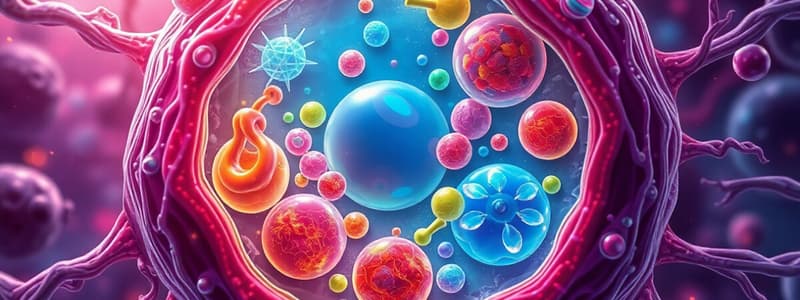Podcast
Questions and Answers
What is the primary role of the nucleus within a human cell?
What is the primary role of the nucleus within a human cell?
- Protein synthesis
- Waste processing
- Genetic material storage and regulation (correct)
- Energy production
Which process within the cell is directly responsible for ATP production?
Which process within the cell is directly responsible for ATP production?
- Photosynthesis
- Osmosis
- Diffusion
- Cellular respiration (correct)
What percentage of the human body is composed of the four key elements (C, H, O, N)?
What percentage of the human body is composed of the four key elements (C, H, O, N)?
- 85%
- 100%
- 75%
- 96% (correct)
Which of the following cell organelles is involved in processing and transporting proteins?
Which of the following cell organelles is involved in processing and transporting proteins?
What is the function of the plasma membrane in a human cell?
What is the function of the plasma membrane in a human cell?
How does hypoxia affect cellular metabolism?
How does hypoxia affect cellular metabolism?
Which organelle is responsible for lipid synthesis and detoxification in the cell?
Which organelle is responsible for lipid synthesis and detoxification in the cell?
What is the primary consequence of cellular injury?
What is the primary consequence of cellular injury?
What is the primary function of the plasma membrane in a cell?
What is the primary function of the plasma membrane in a cell?
Which organelle is responsible for the synthesis of proteins?
Which organelle is responsible for the synthesis of proteins?
Which component of the cell is involved in packaging and modifying proteins?
Which component of the cell is involved in packaging and modifying proteins?
What role do lysosomes play in the cell?
What role do lysosomes play in the cell?
Which of the following options accurately describes the smooth endoplasmic reticulum?
Which of the following options accurately describes the smooth endoplasmic reticulum?
Which component helps maintain the cell's shape and support?
Which component helps maintain the cell's shape and support?
What structure is known as the powerhouse of the cell?
What structure is known as the powerhouse of the cell?
What is contained in the nucleolus?
What is contained in the nucleolus?
Which of the following structures is involved in the transport of materials within the cell?
Which of the following structures is involved in the transport of materials within the cell?
What do ribosomes primarily use to create proteins?
What do ribosomes primarily use to create proteins?
What is the primary function of the sodium-potassium pump in cell membranes?
What is the primary function of the sodium-potassium pump in cell membranes?
What characteristic of the phospholipid bilayer allows it to form a barrier to certain substances?
What characteristic of the phospholipid bilayer allows it to form a barrier to certain substances?
Which statement accurately describes facilitated transport?
Which statement accurately describes facilitated transport?
What is meant by the term 'transport maximum' in the context of cell membranes?
What is meant by the term 'transport maximum' in the context of cell membranes?
What role does cholesterol play in the plasma membrane?
What role does cholesterol play in the plasma membrane?
Why can water pass freely through the plasma membrane while larger molecules cannot?
Why can water pass freely through the plasma membrane while larger molecules cannot?
What distinguishes active transport from passive transport mechanisms?
What distinguishes active transport from passive transport mechanisms?
What is the primary function of specialized protein carriers in cell membranes?
What is the primary function of specialized protein carriers in cell membranes?
What is the primary role of mitochondria in the context of aerobic respiration?
What is the primary role of mitochondria in the context of aerobic respiration?
During which stage of aerobic respiration is ATP produced in the mitochondrial matrix?
During which stage of aerobic respiration is ATP produced in the mitochondrial matrix?
What happens to the respiration process when the body cannot supply enough oxygen during intense exercise?
What happens to the respiration process when the body cannot supply enough oxygen during intense exercise?
What is a byproduct of anaerobic respiration?
What is a byproduct of anaerobic respiration?
Which type of cells would you expect to have the highest number of mitochondria?
Which type of cells would you expect to have the highest number of mitochondria?
What is the main advantage of aerobic respiration over anaerobic respiration?
What is the main advantage of aerobic respiration over anaerobic respiration?
Where does glycolysis take place within a cell?
Where does glycolysis take place within a cell?
What is the role of oxygen in aerobic respiration?
What is the role of oxygen in aerobic respiration?
What happens to pyruvate when oxygen is plentiful?
What happens to pyruvate when oxygen is plentiful?
What is the first step that occurs when pyruvate enters the mitochondria?
What is the first step that occurs when pyruvate enters the mitochondria?
What is produced during the conversion of pyruvate that will be used later in cellular respiration?
What is produced during the conversion of pyruvate that will be used later in cellular respiration?
The Krebs cycle begins with the combination of acetyl-CoA and which molecule?
The Krebs cycle begins with the combination of acetyl-CoA and which molecule?
During the Krebs cycle, what happens to citric acid as it undergoes chemical changes?
During the Krebs cycle, what happens to citric acid as it undergoes chemical changes?
Which of the following is a waste product released during the conversion of pyruvate to acetyl-CoA?
Which of the following is a waste product released during the conversion of pyruvate to acetyl-CoA?
What type of reaction series does the Krebs cycle represent?
What type of reaction series does the Krebs cycle represent?
Which molecule acts as a helper in the conversion of pyruvate to acetyl-CoA?
Which molecule acts as a helper in the conversion of pyruvate to acetyl-CoA?
Flashcards are hidden until you start studying
Study Notes
Levels of Organisation
- Human body comprises four key elements: carbon (C), hydrogen (H), oxygen (O), and nitrogen (N), constituting 96% of body composition.
- The human body originates from a single cell (zygote) formed by the fusion of ovum and spermatozoon during fertilization, followed by multiple cell divisions leading to specialized cells in the developing fetus.
Cell Structure and Function
- A typical human cell contains various organelles: nucleus, cytoplasm, plasma membrane, endoplasmic reticulum (both rough and smooth), lysosomes, Golgi apparatus, ribosomes, and mitochondria.
- The plasma membrane protects cellular contents, regulating what enters and exits, and consists of a bilayer of phospholipids with embedded proteins, sugars, and cholesterol.
Cell Transport Mechanisms
- Transport mechanisms include passive diffusion, facilitated transport, and active transport.
- Small molecules like water can pass freely, while larger molecules rely on specific pores or protein carriers.
- The sodium-potassium pump uses active transport to maintain ion concentrations across the membrane, crucial for cellular functions and consuming up to 30% of ATP.
Energy Production in Cells
- Cellular respiration occurs in three stages: glycolysis (in the cytoplasm), Krebs cycle (in mitochondrial matrix), and electron transport chain (on mitochondrial cristae).
- Glycolysis breaks down glucose into two pyruvate molecules, producing energy carriers (NADH) needed for later stages.
Aerobic vs. Anaerobic Respiration
- During aerobic respiration, glucose is broken down using oxygen to produce ATP, primarily in mitochondria. This process yields high ATP but requires time and adequate oxygen supply.
- In anaerobic conditions, such as intense exercise, glucose is partially broken down into lactic acid, allowing for energy production without oxygen.
The Krebs Cycle
- The Krebs cycle (citric acid cycle) processes acetyl-CoA to produce energy-rich carriers (NADH, FADH2) and a small amount of ATP while releasing carbon dioxide as a waste product.
- The formation of citric acid from acetyl-CoA initiates a series of reactions that gradually release energy captured by carriers.
Clinical Relevance
- Understanding cellular mechanisms is crucial in pre-hospital care contexts, as energy production disruptions (e.g., due to hypoxia or shock) can severely impact cell function and overall homeostasis.
Studying That Suits You
Use AI to generate personalized quizzes and flashcards to suit your learning preferences.




